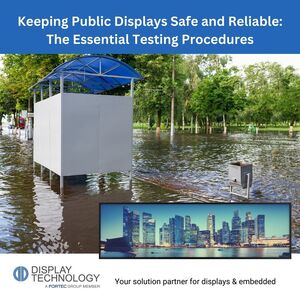
When you're out and about in public spaces like airports, train stations, shopping malls, and museums, you'll often encounter displays that provide information, entertainment, and advertising. These displays are designed to withstand the rigours of public use, and they undergo several tests to ensure their reliability, durability, and safety.
Here are the tests that displays have to go through before they can be used in public spaces:
-
Temperature and Humidity Tests Displays must be tested to ensure they can operate under different temperature and humidity conditions. These tests are conducted to simulate the extreme temperature changes that displays may experience in public spaces. Displays must be able to function under a wide range of temperatures and humidity levels to ensure they are reliable and durable.
-
Vibration Tests Displays undergo vibration tests to simulate the conditions that they will be subjected to when they are in use. These tests help to ensure that the displays can withstand vibrations and continue to function correctly. Vibration tests are particularly important for displays that are mounted on vehicles or movable structures.
-
Drop and Impact Tests Displays are designed to withstand accidental impact and rough handling. The drop and impact tests are designed to simulate the effects of accidental impact. The displays must pass these tests to ensure they can survive the impact and continue to function correctly. The IK09 test is conducted to test the resistance of the displays to mechanical impacts. The test involves dropping a 5 kg object from a height of 20 cm onto the display. The display must withstand the impact without breaking or showing any signs of damage to meet the IK09 standard.
-
Environmental Tests Displays must be tested to ensure they can withstand exposure to different environmental factors such as sunlight, water, and dust. These tests are designed to simulate the conditions that the displays will be exposed to when they are in public spaces. Displays must pass the environmental tests to ensure they can withstand harsh environmental conditions.
-
Electrical Safety Tests Displays undergo electrical safety tests to ensure they are safe for use in public spaces. These tests check for electrical shock hazards and other electrical safety concerns. The displays must meet the required electrical safety standards before they can be deployed in public spaces.
-
Soaking Tests Displays are tested to ensure they can withstand exposure to water. The soaking test is designed to test the resistance of the displays to water penetration. During the test, the displays are submerged in water for a specified period. This test ensures that the displays can withstand exposure to rain or other water sources in public spaces.

